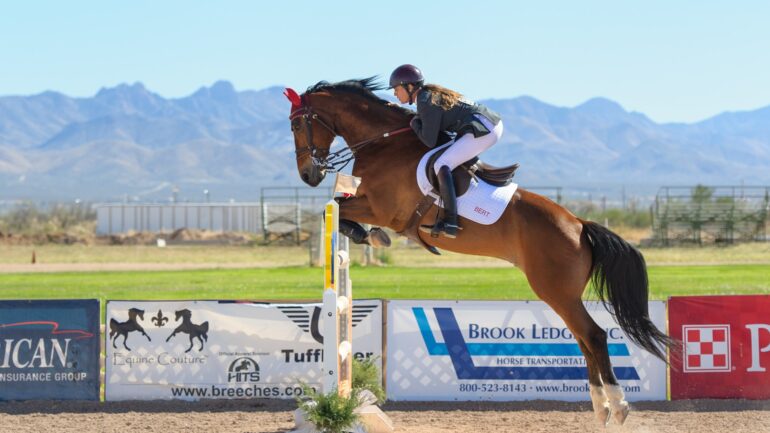You may feel uncomfortable jumping over large fences when you’re a beginner. However, feel free to practice at lower heights and with more straight lines of borders to build your confidence, balance & security. You can practice at home by setting up a course of poles in your backyard. Trot with your horse over the fences and count the strides before you jump each time. It will help you to memorize the course and improve your timing.
Practice Your Balance
If you lose your balance, your body’s automatic response is to grip with your legs and brace your shoulders, which stiffens up your joints and hinders movement.
Keeping your balance in horse jumping is essential, especially for beginners. If you need to be correctly balanced, you might fall over a fence or even lose your horse’s confidence and start to panic.
One exercise you can do to improve your balance is “figure-eight.” Pick up the trot and put one hand on your hip, then the other on the reins. Change sides around a curve, and keep changing hands until your hand is on the hips for the entire circle.
You can also work on your balance by practicing the modified three-point jumping position in walk and trot. Try it for a few practice runs, and have a schooling horse jumps so that you can critique your riding style! These tips will help you build confidence and increase your chances of winning in the arena.
Practice Your Position
The first step to preparing for a jump is to ensure you have a strong position at the walk, trot and canter. It will help you maintain your balance and prevent you from getting thrown off your horse’s back as you approach the fence.
Practicing your position at these gaits will also improve your suppleness and ability to adjust to the changes in direction that may occur while jumping. Developing a comfortable two-point place is also essential, as this will become your dominant riding position over fences.
The 2-point position shifts your center of gravity forward to match the horse’s jumping effort and reduces your chances of slipping off your horse’s back as you overcome the obstacle. Practice this on the flat or over poles in all three gaits; you should improve your position over time.
Practice Your Release
Practicing the release at small jumps helps you perfect your balance and the following freedom over fences. You don’t want to release too soon – that will “drop” your horse and make it scoot forward, making it easier for you to get ahead or left behind!
Generally, beginner riders use an extended crest release, which involves pressing your hands into the horse’s crest or the sides of his neck just below it. It allows you to follow his head and neck over the jump as he lowers without interfering with his mouth.
It also provides maximum position support (you can balance your upper body on his neck, rather than letting your weight shift onto his back or shoulders) while guaranteeing complete freedom of his head and neck. Advanced riders use the automatic release, which requires your hands to move alongside his head and neck, maintaining a straight line from your elbow to your hand to his mouth. It improves communication and helps you stay with his motion over the jump, reducing the risk of jumping ahead or behind him.
Practice Your Speed
One of the essential tips for beginners in horse jumping is to practice your speed when jumping. You must develop this technique throughout your training to safely ride your horse.
When jumping over a giant fence, getting distracted and forgetting your technique is easy. When you do this, your horse may jump across the wall or flatten out, resulting in a terrible photograph.
It would be best to focus on the proper distance ahead of you when jumping. It is called ‘the line of approach’ and takes time to establish.





